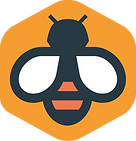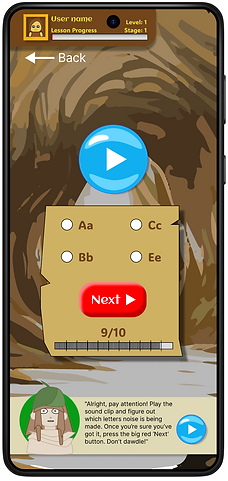
Role: Research, design, prototyping, and testing.
Timeline ongoing
Design Goal: Create an English literacy learning resources that is approachable, fun and easy to use.
Product Goal: Engage user in fun and unimposing way to develop there reading skills
Meet Budiwati:

She's a 27 year old small business owner born and raised in Raja Ampat, Indonesia
Users: Individuals who are relativly fluent in spoken English but lack literacy skills, including non-native speakers and those who have not had the opportunity to learn to read for various reasons


Wow!
Amazing where do I sign up?
Hi I'm here representing the Indonesian tourism board, We love your locally sourced and sustainable, you are a great fit to have attraction page. Should help drive sales for your business while helping the local economy!

Just pop on to our site and fill out the application
Great thanks

English?

I can't read English! This can really destroy a good opportunity

I need a way to learn to read. I need Something engaging that can quickly take me through the basics, and will also keep me motivated to keep learning
Competitive Analysis
Interface
Navigation and Layout | Simple, tab-based with clear progress tracking | Scrollable library format | Course-based, modular structure |
Visual Style | Gamified, colorful, engaging characters | Clean UI with audiobook-style | visuals Simple, engaging, memory-focused |
Reading Experience | Readability Large, bold fonts; spaced text for clarity | Dual-text display with highlights | Simple text blocks with pronunciation aids |




Hmmm what can be put together that has a competitive edge with these insights?
Accessible, high-contrast, intuitive gamified |
Designed for non-readers, clear iconography |
Dyslexia-friendly fonts, customizable contrast |
Engagement and User Motivation
Gamification | Gamification XP points, streaks, leaderboards | Interactive reading challenges | Memory training, streaks Progress |
Personalization | Adaptive difficulty, AI-based lesson suggestions | User-selected stories & texts | AI-driven vocabulary repetition |
Community
Features | Social leaderboards, clubs | No direct community engagement | User-generated content, shared courses |
badges, real-world goal tracking
Personalization |
Custom reading paths based on literacy level |
Peer support, live tutoring options |
Learning Features & Tools
Progress Tracking | Levels, badges, daily goals | Reading time tracking | AI-driven spaced repetition |
Audio Support | Text-to-speech, native speaker audio | Side-by-side audio-text sync | Native pronunciation clips |
Offline Learning | Limited, premium only | Yes | Yes |
Story-based milestones, real-world reading benchmarks |
Interactive read-aloud & speech recognition |
Is a must! |
Accessibility& Inclusivity
Multi-Language Support | 40+ languages | Multilingual audiobooks | 20+ languages |
Voice & Audio Feedback | Voice & Audio Feedback | Text-to-speech, voice lessons | Audiobook narration |
Text Customization | Text Customization Basic font & size settings | Default settings, limited control | No major customization |
Focused on English literacy |
Native speaker clips |
Full customization (fonts, contrast, modes) |
Foundations of learning to Read
identify the main idea of what is written
Expand vocabulary and start to focus on user needs

Vocabulary
Text comprehension
Phonological sensitivity and
blending
Syntax
Phonic Awarness
Learn the Alphabet and the sounds each letter carries
Learn combination letter sounds like th,, sh, tion,, and letter blending
Basic sentence structure


So this is how you are going to start my literacy journey?
Design architecture

Wireframes
Progression map:
Designed to make the journey to reading clear.
Lesson One:
Connecting sounds with letter forms.

First test:
Test how much of the Alphabet the user has learned.

User testing

Insights:
-
user is engaged by the gamification design
-
Buttons and interactive elements need to be more clearly defined
"Well this is more than a little confusing I don't know what's a button and what isn't. I do like the idea of a map though reminds me of candy land"
"This is a lot to memorize all at once maybe it can be broken up into smaller parts?
And that user bat at the top take up a lot of space for the amount of information its giving me!"

Insights:
-
keep the information bite sized
-
streamline screen elements to reduce clutter
"Again having to memorize the whole alphabet all at once is a lot and only passing if I get all 26 correct in a row to move on makes me feel overwhelmed "
Insights:
-
Make tests shorter to increase success rate and help user stay engaged, this should help the user be more consistent


User testing
Mockup
OK! that sorts out a manageable amount of content to consume. What about incentive






Achievements:
Unlockable gear and customizable avatars
Results and Outcomes
Developing LitQuest has been an adventure in its own right! Discovery, iteration, and problem-solving being perilous side quests along the way. Initially, one of the biggest challenges was designing an interface that catered to users who couldn’t read while still being intuitive and engaging. Traditional navigation patterns often relied on text-based instructions, which created an immediate barrier. Through testing, I realized that incorporating voice guidance, icon-based navigation, and interactive feedback was essential in making the experience accessible.
Another hurdle was ensuring that users felt motivated rather than overwhelmed. Early versions of the app had too many options upfront, making it difficult for users to know where to start. Simplifying the onboarding process and integrating gamified progression, visual cues, and real-time feedback helped reduce hesitation and kept learners engaged.
One of the most enlightening moments came when I observed how users interacted with audio-visual learning tools. I initially underestimated how crucial word chunking, phonetic breakdowns, and repetition were for retention. Once implemented, these features significantly improved user confidence and engagement.
Through continuous testing and iteration, I learned that simplicity, accessibility, and personalization are key to an effective literacy learning tool.

